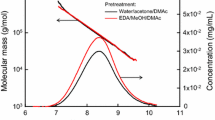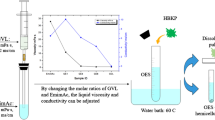Abstract
Background, aims, and scope
Currently, elemental chlorine-free (ECF) and totally chlorine-free (TCF) bleaching systems are widely used for pulp production. Low and medium molecular weight lignin break-down products are known to have harmful effects on the environment. According to some recent results, also high molecular weight (HMW) material consisting mainly of lignin and carbohydrates may cause toxic effects to the environment. For these reasons, toxicity and structure studies of HMW materials are of great importance. This investigation is a part of a larger project to obtain more structure information of HMW materials and toxicity of ECF and TCF bleaching effluents. Size-exclusion chromatography (SEC) has been commonly used for the characterization of organic macromolecules such as lignin, but to our knowledge, no reports have appeared dealing with the comparison of SEC of ECF and TCF bleaching liquors. The aim of the present study was to get more information about the molecular weight distribution (MWD) of HMW fractions of waste liquors from ECF and TCF bleaching sequences by SEC.
Methods
The MWDs of organic materials dissolved during different stages of ECF bleaching (O-D-EOP-D-ED) and TCF bleaching (O-Z-Q-P-Z-Q-P-P) of softwood (Pinus sylvestris) kraft pulp were determined and compared by SEC. All effluent samples from the above bleaching stages were ultrafiltrated using a membrane with a cutoff value of 1,000 Da. SEC was performed on high and also low molecular weight fractions and non-fractionated effluents. In the SEC experiments, a Superdex 75 column was used with 0.1 M NaOH solution as the eluent. Standards used for calibrating the SEC system were albumin, carboanhydrase, cytochrome C, tannic acid, dehydrodiacetovanillone, and vanillin.
Results and discussion
The chromatograms of liquors from TCF bleaching stages vary more than those from ECF bleaching. Peroxide and chelating stages contained mostly high molecular weight (HMW) matter whereas chlorine dioxide and ozone stages had more low molecular weight compounds. The lignin content in HMW matter was higher than in stages that consisted of low molecular matter. Bleaching effluents contained the highest amounts of HMW material, mainly lignin, in the beginning of the sequences; the amounts decreased towards the end of the bleaching sequence.
Conclusion
Determinations of MWD by the SEC method showed that effluents from the TCF sequence contained more HMW material than those from the ECF stage. This might be due to peroxide stages (P) that dissolve HMW lignin effectively. However, the molecular weights of ozone stages (Z) were very low compared to other stages. Chlorine dioxide stages also dissolved mostly low molecular weight lignin. Ultrafiltration of bleaching liquors showed that high molecular weight fraction also included some low molecular weight compounds and vice versa. High polydispersity and high lignin content correlated with the amount of HMW material in ECF and TCF bleaching stages.
Recommendation and outlook
Our liquor samples were studied by using a UV detector commonly used for lignin preparations; in upcoming investigations, it will be interesting to determine carbohydrates such as hemicelluloses. The results are applicable in papermaking in order to improve commonly used bleaching procedures, to test new potential bleaching systems, and to study chemical behavior of HMW materials in various bleaching liquors. The present results also form a good basis for toxicity measurements of ECF and TCF bleaching effluents and for more comprehensive spectroscopic and chromatographic experiments with samples taken from various bleaching stages. From the behavior of liquors studied, it appears that our other structure investigations by spectroscopic and chromatographic (NMR, Py-GC/MS, etc.) methods mostly correlate well with the present results.








Similar content being viewed by others
References
Alén R, Hartus T (1988) UV spectrophotometric determination of lignin from alkaline pulping liquors. Cellulose Chem Technol 22:613–618
Ali M, Sreekrishnan T (2001) Aquatic toxicity from pulp and paper mill effluents: a review. Adv Environ Res 5:175–196
Bikova T, Klevinska V, Treimanis A (2000) Monitoring of lignin and hemicelluloses in spent cooking liquor during kraft delignification. Holzforchung 54:66–70
Fuhrmann A, Li X-L, Rautonen R (1997) Effects of ECF and TCF bleaching sequences on the properties of softwood kraft pulp. J Pulp Pap Sci 23:J487–J493
Hongve D, Baann J, Becher G, Lömo S (1996) Characterization of humic substances by means of high-performance size-exclusion chromatography. Environ Internat 22:489–494
Jacobs A, Dahlman O (2000) Absolute molar mass of lignins by size-exclusion chromatography and MALDI-TOF-mass spectroscopy. Nord Pulp Pap Res J 15:120–127
Kukkola J, Knuutinen J, Paasivirta J, Herve S, Pessala P, Schultz E (2006) Characterization of high molecular mass material in ECF and TCF bleaching liquors by Py-GC/MS with and without TMAH methylation. J Anal Appl Pyrol 76:214–221
Paasivirta J, Kukkola J, Knuutinen J, Pessala P, Schultz E, Herve S (2005) Multivariate statistics of the pyrolysis products of high molecular components in pulping wastewaters to explain their toxicity. Environ Sci Pollut Res 12:375–380
Pellinen J, Salkinoja-Salonen M (1985) Aqueous size exclusion chromatography of industrial lignins. J Chromatogr 322:129–138
Pessala P, Keränen J, Schultz E, Nakari T, Karhu M, Ahkola H, Knuutinen J, Herve S, Paasivirta J, Ahtiainen J (2009) Evaluation of biodegradation of nonylphenol ethoxylate and lignin by combining toxicity assessment and chemical characterization. Chemosphere 75:1506–1511
Pessala P, Schulz E, Kukkola J, Nakari T, Knuutinen J, Herve S, Paasivirta J (2010) Biological effects of high molecular weight lignin derivatives. Ecotoxicol Environ Saf 73:1641–1645
Ristolainen M, Alén R, Knuutinen J (1996) Characterization of TCF effluents from kraft pulp bleaching. I. Fractionation of hardwood lignin-derived material by GPC and ultrafiltration. Holzforschung 50:91–96
Sierra-Alvarez R, Lettinga G (1991) The methanogenic toxicity of wastewater lignins and lignin related compounds. J Chem Tech Biotechnol 50:443–455
Sjöholm E, Gustafsson K, Berthold F, Colmsjö A (2000) Influence of the carbohydrate composition on the molecular weight distribution of kraft pulps. Carbohydr Polym 41:1–7
Sponza D (2003) Application of toxicity tests into discharges of the pulp-paper industry in Turkey. Ecotoxicol Environ Saf 54:74–86
Vidal G, Videla S, Diez M (2001) Molecular weight distribution of Pinus radiata kraft mill wastewater treated by anaerobic digestion. Biores Technol 77:183–191
Virtapohja J (1996) The use and determination of chelating agents (EDTA and DTPA) in TCF bleaching. International Pulp Bleaching Conference, Washington, D.C., April 1996, 2:537–539
Wallberg O, Jönsson A, Wimmerstedt R (2003) Fractionation and concentration of kraft black liquor lignin with ultrafiltration. Desalination 154:187–199
Wallis A, Wearne R (1994) Characterization of the high molecular mass organic material in filtrates from bleaching eucalypt kraft pulps. Appita J 47:309–314
Wong K, de Jong E (1996) Size-exclusion chromatography of lignin- and carbohydrate-containing samples using alkaline eluents. J Chromatogr A 737:193–203
Acknowledgments
The authors thank the Finnish Environment institute and Central Finland Regional Environment Centre for financing the research.
Author information
Authors and Affiliations
Corresponding author
Additional information
Responsible editor: Philippe Garrigues
Rights and permissions
About this article
Cite this article
Kukkola, J., Knuutinen, J., Paasivirta, J. et al. Size-exclusion chromatographic study of ECF and TCF softwood kraft pulp bleaching liquors. Environ Sci Pollut Res 18, 1049–1056 (2011). https://doi.org/10.1007/s11356-011-0556-7
Received:
Accepted:
Published:
Issue Date:
DOI: https://doi.org/10.1007/s11356-011-0556-7




